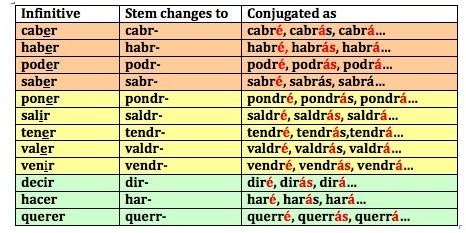Using the Future Tense in Spanish
Forming the Future Tense
Nearly every Spanish verb forms its future tense by adding the endings -é, -ás, -á, emos , -éis, -án to the infinitive (-ar, -er, or -ir form of the verb). Exceptions are discussed in the next section of this article. Click on the chart below for conjugations of three regular Spanish verbs.
Irregular Future Tense Verbs
While the endings remain consistent, some Spanish verbs have irregular future verb stems. (The verb stem is what you get when you chop off the -ar, -er, and -ir endings.) Some (caber, haber, poder, saber) drop the -e of the infinitive ending. Others (poner, sal****ir__, tener, valer, venir) replace the -e or -i of the infinitive ending with -d. Still others (decir, hacer, querrer) follow no particular pattern and must be memorized. Click on the chart below for a list of these irregular future verb stems.

Talking About the Future in Spanish
Spanish uses the future tense in the following ways:
- To talk about future events. In Spanish (as in English) the future tense is used to convey an action or state of being that will occur at some time in the future:
Lo haré. I will do it.
Iremos al campo el mes que viene. We will go to the country next month.
- To express conjecture or probability regarding the present:
¿Qué hora será? I wonder what time it is.
¿Cómo estarán mis hijos? I wonder how my children are doing.
Tendrá muchos amigos. He must have many friends.
**¿**Habrán llegado? Do you suppose they have arrived?
- In an indirect quotation:
María dice que vendrá mañana. Mary says that she will come tomorrow.
- In the main clause of sentences where the present subjunctive follows a conjunction of time (cuando, después (de) que, en cuanto, hasta que, and tan pronto como):
Cuando pase la tormenta iremos a tu casa. When the storm stops, we will go to your house.
Estaremos aquí hasta que nos aburramos. We will be here until we get bored.
- To state a strong command:
Comerás las zanahorias. You will eat your vegetables.
Substituting for the Future Tense in Spanish
Spanish speakers tend to use the future tense less frequently than we do in English. Ways in which they avoid using the simple future tense are as follows:
- The ir a + [infinitive]
Vamos a llegar a la costa mañana. We will arrive at the coast tomorrow.
- The simple present tense with an obvious adverb:
Nos vemos después. We’ll see each other later.
- The present subjunctive to imply the future:
Dudo que mis padres vengan. I doubt that my parents will come.
- With the verb querer to express a sense of willingness:
¿Quieres ayudarme? Will you please help me?
¿No quieren comer? Won’t you please eat?
Read more online about the future tense in Spanish.
StudySpanish.com - The Future Tense in Spanish (Study and generate random quizzes)
[](https://www.elearnspanishlanFuturo - Spanish Future Tense - Usage)Fred F. Jehle’s web page - The Future Tense
